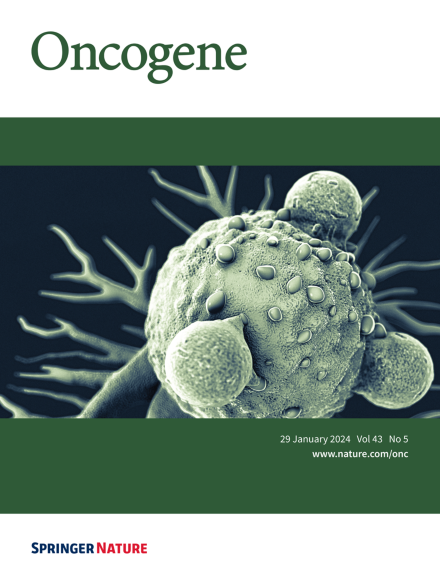通过N6AMT1-NEDD4L途径介导的p110α降解逆转内分泌抗性。
IF 6.9
1区 医学
Q1 BIOCHEMISTRY & MOLECULAR BIOLOGY
引用次数: 0
摘要
大约70%的乳腺癌(BC)病例为光型(雌激素受体阳性,ER+),适合内分泌治疗,他莫昔芬是最常用的药物。然而,约30%的这些患者由于各种机制而产生他莫昔芬耐药,主要涉及通过突变或未知途径激活PI3K通路。在这里,我们通过生物信息学分析和临床样本发现,N6腺嘌呤特异性DNA甲基转移酶1 (N6AMT1)在腔内乳腺癌中高表达,但在他莫昔芬耐药(TamR) BC细胞中下调。ChIP-qPCR和荧光素酶报告基因检测显示FOXA1结合N6AMT1启动子并增强其转录。在TamR模型中,FOXA1和N6AMT1下调,增加p110α蛋白水平(但不增加mRNA)、磷酸化akt水平和他莫昔芬耐药性。在体内,N6AMT1过表达增强了他莫昔芬的敏感性,而敲低则降低了他莫昔芬的敏感性;p110α抑制剂A66可以恢复这种敏感性。临床上,N6AMT1表达降低与腔内BC患者预后不良相关。在TamR BC类器官中,与单独治疗相比,他莫昔芬联合A66进一步降低了生长。机制上,p110α水平升高是由于E3泛素连接酶NEDD4L抑制降解所致。这些发现表明N6AMT1可能是一种潜在的腔内乳腺癌生物标志物,并强调N6AMT1-p110α途径是使细胞对他莫昔芬敏感的治疗靶点。本文章由计算机程序翻译,如有差异,请以英文原文为准。

Reversal of endocrine resistance via N6AMT1-NEDD4L pathway-mediated p110α degradation
Approximately 70% of breast cancer (BC) cases are luminal-type (estrogen receptor-positive, ER+), suitable for endocrine therapy with tamoxifen as the most commonly used drug. However, about 30% of these patients develop tamoxifen resistance due to various mechanisms, primarily involving PI3K pathway activation through mutations or unknown pathways. Here, we discover, via bioinformatics analysis and clinical samples, that N6 adenine-specific DNA methyltransferase 1 (N6AMT1) is highly expressed in luminal breast cancer but downregulated in tamoxifen-resistant (TamR) BC cells. ChIP-qPCR and luciferase reporter assays showed that FOXA1 binds to the N6AMT1 promoter and enhances its transcription. In TamR models, FOXA1 and N6AMT1 are downregulated, increasing p110α protein levels (but not mRNA), phospho-AKT levels, and tamoxifen resistance. In vivo, N6AMT1 overexpression enhanced tamoxifen sensitivity, while knockdown reduced it; this sensitivity could be restored with the p110α inhibitor A66. Clinically, decreased N6AMT1 expression correlates with poor prognosis in luminal BC patients. In TamR BC organoids, combining tamoxifen with A66 further reduced growth compared to either treatment alone. Mechanistically, increased p110α levels result from inhibited degradation by E3 ubiquitin ligase NEDD4L. These findings suggest N6AMT1 as a potential luminal breast cancer biomarker and highlight the N6AMT1-p110α pathway as a therapeutic target to sensitize cells to tamoxifen.
求助全文
通过发布文献求助,成功后即可免费获取论文全文。
去求助
来源期刊

Oncogene
医学-生化与分子生物学
CiteScore
15.30
自引率
1.20%
发文量
404
审稿时长
1 months
期刊介绍:
Oncogene is dedicated to advancing our understanding of cancer processes through the publication of exceptional research. The journal seeks to disseminate work that challenges conventional theories and contributes to establishing new paradigms in the etio-pathogenesis, diagnosis, treatment, or prevention of cancers. Emphasis is placed on research shedding light on processes driving metastatic spread and providing crucial insights into cancer biology beyond existing knowledge.
Areas covered include the cellular and molecular biology of cancer, resistance to cancer therapies, and the development of improved approaches to enhance survival. Oncogene spans the spectrum of cancer biology, from fundamental and theoretical work to translational, applied, and clinical research, including early and late Phase clinical trials, particularly those with biologic and translational endpoints.
 求助内容:
求助内容: 应助结果提醒方式:
应助结果提醒方式:


